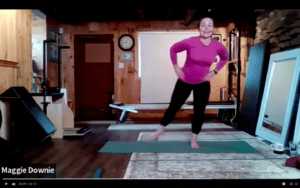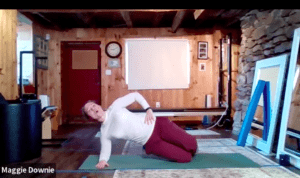The shortest workout you need sounds too good to be true. It sounds like a gimmick, but there is research that supports its effectiveness. But while it’s short, it will be challenging.
Professor of kinesiology, Martin Gibala, and his team have shown that a specific 10-min, intense interval workout three times per week was as effective as 30-minutes of moderate exercise four times per week. What’s great about that news is that it means if you’ve said in the past, “I don’t have time to work out,” now you really have no excuse. Ten minutes can provide great impact on the body and your health.
 Equally effective meant people seem to have very similar results in multiple health markers, including insulin sensitivity, VO2 max (how we utilize oxygen during exercise), and at a cellular level our mitochondria responded similarly.
Equally effective meant people seem to have very similar results in multiple health markers, including insulin sensitivity, VO2 max (how we utilize oxygen during exercise), and at a cellular level our mitochondria responded similarly.
Just to see those numbers a different way—30-minutes of high intensity interval work throughout the week yielded the same results as 120-minutes of moderate work throughout the week. It’s just a quick way to fit in exercise. It doesn’t mean that one way is better than another. Moderate and vigorous exercise challenge the body in different ways. Both are good. And you don’t need to give up your moderate workout if you love it. But if you aren’t making time for exercise, this might be a place to start (provided your body is okay with the challenge of the workout).
The workout Gibala’s team tested involved the following:
- 2-min warm-up
- 20-seconds of SIT (sprint intensity training)
- 2-minute recovery
- Repeat the 20-sec SIT and 2-min recovery a total of three times.
- 1-minute cool down.
That’s ten minutes total. This research was done with people working on a stationary bike. But they also tested it on a stair climber. The 20-seconds was at a SIT level—that’s all out. You’ll be moving as intensely as you possibly can. Sprint Intensity Training does not mean you have to be running. It’s about how intense you are working not the type of movement. There is SIT (Sprit Interval Training), HIIT (High Intensity Interval Training) and what I call LIIT (Low Intensity Interval Training).
On a scale of 1-10 where 1 is sitting down and 10 is working as hard as you possible can, SIT is a 10. You physically cannot push the body any harder. HIIT requires you to reach about an 8. You should be winded and it should be hard to maintain a conversation, but you do have more to give if you had to (like if a bear started chasing you, you’d find a little more speed). With LIIT you are just getting your heart rate up on an interval pattern.
HIIT and SIT are not for everyone, and you should always talk with your doctor before starting any kind of intense activity to ensure you don’t have any underlying risk factors. Also, some people don’t like working that intensely. For those people there is still moderate exercise. On our number scale moderate exercise would be about a 6. You are winded, but can maintain a conversation.
People often presume HIIT workouts have a lot of jumping and bounding, and they can, but they don’t have to. Consider that Gibala’s research was on a stationary bike. You can turn any move into an interval workout by picking up the pace. It’s about the intensity, not which movement it is.
The research on what is the ideal interval (how long to push and how long to recover is debated), there is not definitive answer. So you can experiment with what you like or change it up for all three workouts each week. The answer seems to be 20-90 seconds of intense work, followed by 20-seconds to 4 minutes of recovery. Some research indicates 8-seconds intense, 12-second recovery is a good combo. Try 8-12 if you want, but I’ll tell you from my experience it just makes me feel spastic. I’m on. I’m off. It’s too quick a change to enjoy any of the movement.
There is debate on what is best for recovery too—should you keep moving at a gentle pace or stop all together? That answer is not known. This provides room to see what works for you. I like to keep moving (no surprise there).
Some things to keep in mind. Research indicates your recovery shouldn’t be so long that you are back to your resting heart rate. But it should be enough that you come out ready to push as much as you can during your intense phase. If you aren’t ready to push, you haven’t had a long enough recovery.
If you are thinking: This sounds awful. I don’t want to work this hard, that’s okay. It’s just an option. Move however makes you feel good. Movement is a miracle medicine. If you already do moderate movement and you’re happy that’s great. I spend so much time trying to convince more people to move, if I find someone who is doing it, I’m hesitant to change anything. But ensuring you challenge your heart and lungs is beneficial (again assuming your doctor agrees). This type of HIIT has shown great workout results in older populations and diabetics. If you progress at your level it an be a great workout option for most people.
If you’re not sure if HIIT is for you, remember that LIIT option. Next time you go for a walk, throughout the walk push yourself for 3 lampposts and then walk at your regular pace. You can just tick it up a notch. It never has to be all or nothing. You can build progressively.
Whatever style of interval you pick, there is a good deal of research on interval training and it all leans to positive benefits. But it’s like anything. You need to know your body.
Like any muscle while it’s good to challenge your heart, you don’t’ want to push it to much too soon, so you also need to know your limits. And you will be moving quickly so you want to pick moves your body is ready for. You do not want to skip the warmup with interval training. And if a move doesn’t feel safe, pick another. Remember, any move can be turned into an interval.
They key takeaway here isn’t that one type of movement is better or worse for you. It’s that you have options. Variety in your workout it is best. And getting up to move throughout the day is key. But, no more excuses: ten minutes can get you great results.
CT Live
Keep Reading
Interested in other workouts you can try on our On Demand Channel? Read up on meditation and pilates on our blog!
Keep Connected
Order Your Copy of Keep Moving Today!
Subscribe to the Keep Moving Blog
Like the Personal Euphoria Facebook page
Find us on Twitter
Follow me on Instagram
Subscribe to my YouTube Channel

